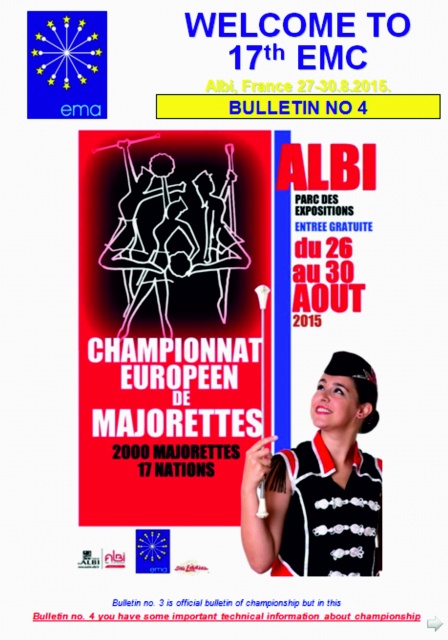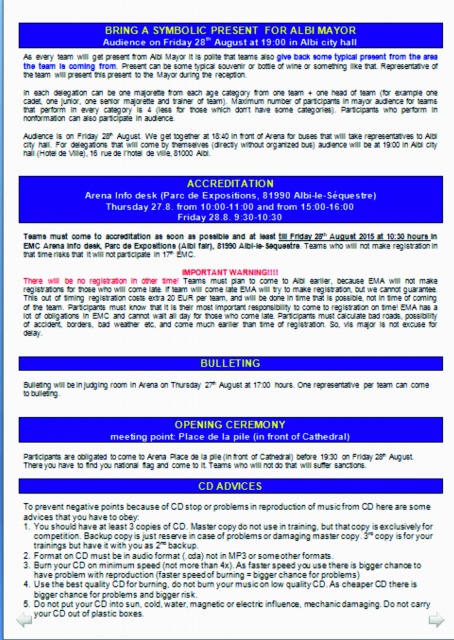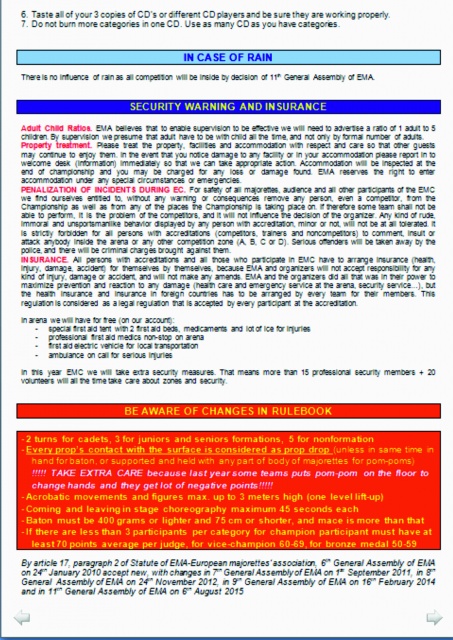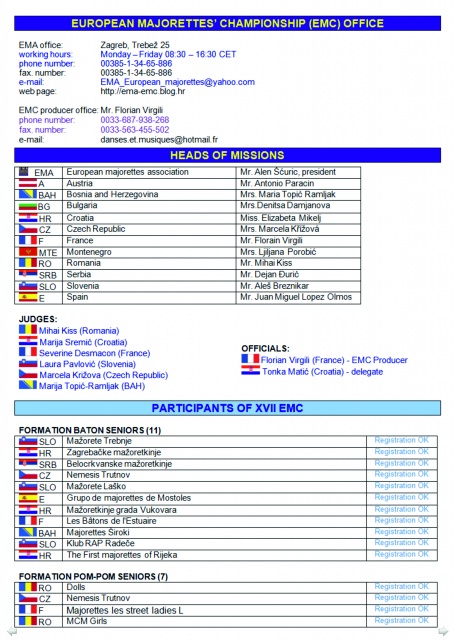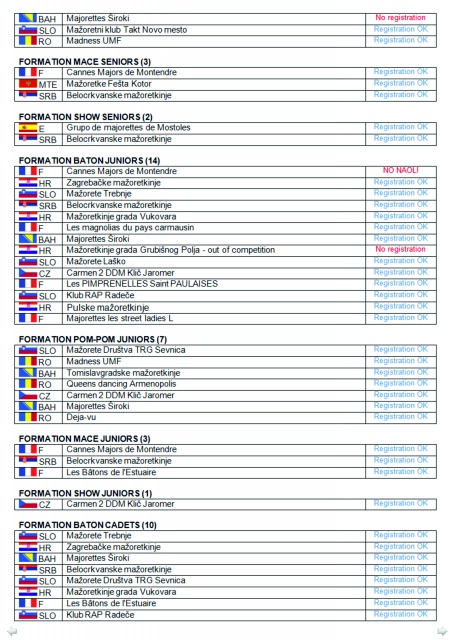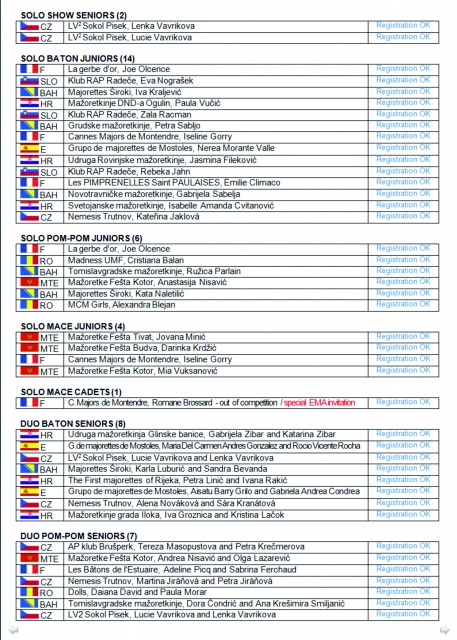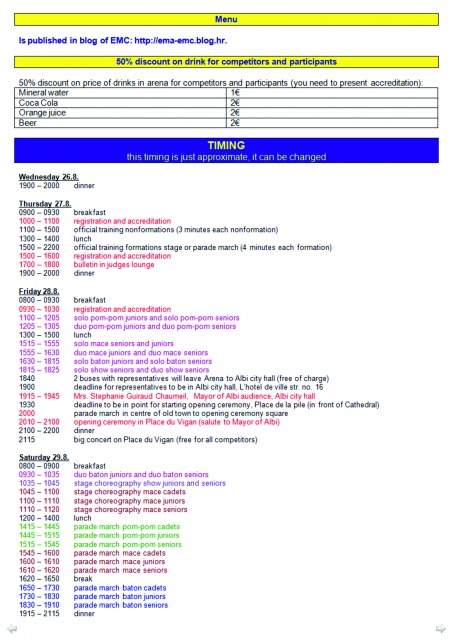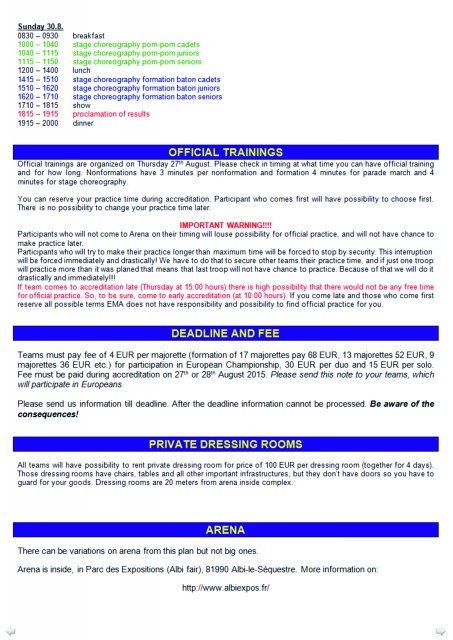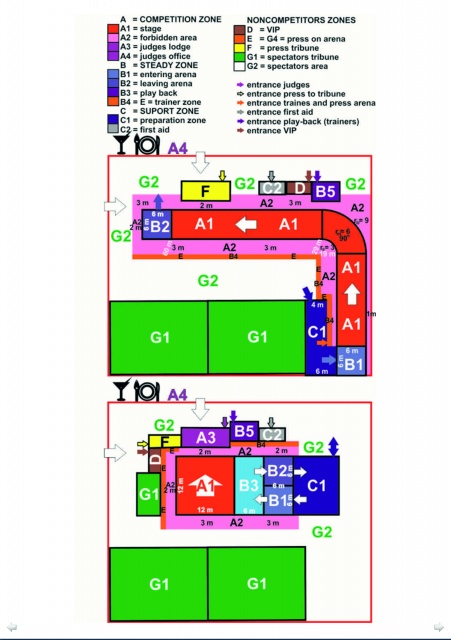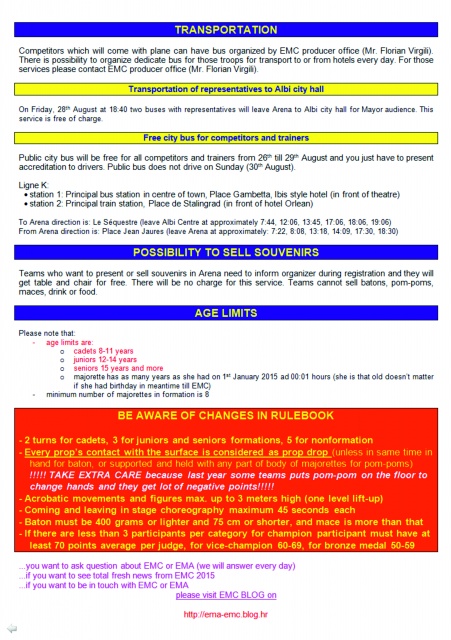BULLETIN NO. 4 - IMPORTANT TECHNICAL INFORMATION ABOUT CHAMPIONSHIP
Click on the photo to enlarge it
By article 17, paragraph 2 of Statute of EMA-European majorettes’ association, 6th General Assembly of EMA on 24th January 2010 accept new, with changes in 7th General Assembly of EMA on 1st September 2011, in 8th General Assembly of EMA on 24th November 2012, in 9th General Assembly of EMA on 16th February 2014 and in 11th General Assembly of EMA on 6th August 2015
EMA RULEBOOK (2015)
1. General regulations
1.1. Introduction
1.1.1. This Rulebook regulates types, forms and course of majorettes' competitions on European level, organized by European majorettes' association (EMA), EMA's members or a third party in the name of those institutions.
1.1.2. Rulebook regulates relations between EMA, competitors, judges, Technical board and majorettes' teams on competitions from article 1.2.
1.2. Rulebook competence (obligation)
1.2.1. Keeping these rules on European majorettes' championship (EMC) and other competitions organized by EMA is necessary.
1.2.2. The rules are recommended for national championships and competitions in member countries of EMA but national differences are allowed.
1.2.3. If something is not defined by this Rulebook judge is allowed to act by his national rulebook.
1.2.4. EMC is the highest competition run by this rulebook.
1.3. Technical board
1.3.1. EMA General Assembly (GA), by the Statute of EMA is allowed to appoint Technical board.
1.3.2. Technical board:
§ takes care that competitions are run according to this Rulebook
§ prepares calendar of the championships
§ takes care of results
§ suggest changes of the Rulebook to the EC (Executive Committee) and GA
§ takes care of other assignments according to the Rulebook
1.3.3. If the Technical board is not appointed, its function is assigned to the EC.
1.4. Judges
1.4.1. International judges are appointed by EMA. EMC and other EMA competition can be judged just by EMA international judges who have EMA license.
1.4.2. For EMC or any competition where EMA international judge is asked to judge EMA Executive committee (EC) is the only body to delegate them. International judges are appointed by EMA and therefore EMA decide who will be judges in those competitions. National competitions with judges from that country is not in jurisdiction of EMA but national association, but international competitions or competitions in one country where they ask judges with EMA license from other countries is in competition of EMA and EMA EC decide which international judge will judge on those competitions.
1.4.3. In EMC or other competitions EMA EC appoints one delegate and minimum 5 and maximum 9 judges. If there is problem in number of judges from different countries, EMA will nominate one more judge from each country.
1.4.4. One of the judges in EMC is head judge, appointed by EMA EC. He is responsible for other judges, control data impute, disqualification and conduct judging.
1.4.5. Replacing judge can be any licensed judge who is accessible to delegate, while simultaneously paying attention to select judges from same country as one to replace, and to select jogs between the present judges or judges in nearby area of competition, in order for a competition to continue within shortest time.
1.4.6. Judges and delegate must come to the official office of competition at least one hour before the official training starts.
1.4.7. Judges judge on official judging lists. They can use other tools (computer, notes etc), but official results must be on judging lists. Parallel with judging lists, judges must keep judging tables, to enter the scores for artistic impression, technical data, prop technique, and general impression. Judging table is a control document, and it is not subject to a public disclosure.
1.5. Delegate
1.5.1. EMA delegate takes care of the regularity of the championship, and forced this Rulebook and Statute of EMA in competition from article 1.2.1.
1.5.2. Delegate accepts the protests, deals with the formal shortcomings and situations such as vis major, controls input date at processing...
1.5.3. Delegate outranks judges during the championship in formal cases.
1.5.4. The delegate can suspend one majorette-team or all competition if organizer, competitors, judges or a third party does not act by this Rulebook or other regulations of EMA and legislative of country where championship is organized.
1.5.5. In case of delegate’s absence, a competition delegate becomes one of the present judges appointed by delegated judges.
2. Types and organization of championship
2.1. European majorettes' championship (EMC)
2.1.1. EMC is official and the most important championship for the title of European majorettes' champion.
2.1.2. Official titles in each form of EMC are:
§ European champion (gold medal)
§ European vice-champion or runner-up (silver medal)
§ Third place or 2nd runner-up (bronze medal)
2.1.3. If in one categories there are less than 3 participants champion can be competitor which earn average of at least 70 points per judge, if competitor earns 60-69 points he/it will get title of vice-champion or 50-59 points bronze medal.
2.1.4. EMC is organized once per year.
2.2. Competitors in EMC
2.2.1. Each country where national championship or qualification cup were held can nominated 3 groups in each category and form. Organizing country can nominate 2 more teams to compete in EMC in each category and form.
2.2.2. 4 the best teams in each category have the right to participate in next year EMC without participation in National championship or qualification tournament. Those teams don’t have the obligation to participate in National championship or qualification tournament for that year. In same time country that has those teams who directly qualified can nominate another 3 groups in each category, or 5 in case that organize EMC on top of those groups. For nonformation the same rule exzists just in case that nonformation consists of same girls in same age class.
2.2.3. In countries where national championship or qualification cup was not organized EC can accept groups without qualifications. EC will accept first 3 groups which will send registration form or on some other principle which must be clearly put in official invitation.
2.2.4. Groups in same EMC can compete in baton, pom-pom, mace and show majorettes form.
2.2.5. If some of nominated groups do not send registration form, EC can accept another group instead from the same country.
2.3. Organizer obligations
2.3.1. The organization of EMC or other competitions from article 1.2.1. is under the authority of EMA. Realization of those competitions can be trusted to one national association or majorette-team or to third organizer supported by one majorette-team. Realization is constantly instructed and coordinated by EMA.
2.3.2. Organization of each championship from article 1.2.1. must be authorized by EMA as regulated in this Rulebook.
2.3.3. Organizer of EMC is obligated to:
§ pay for all costs of judges and delegate (travel expanses, lodging, food, fee etc.)
§ provide judging room with equipment
§ provide arena and all other official areas of competition by this Rulebook
§ provide cups and medals by this Rulebook
§ provide all costs of computer operator
§ provide other costs by Study for organizing EMC
2.3.4. The organizer is morally and materially responsible for the realization.
2.3.5. The organizer and all involved are obligated to speak at least a beginner level of English.
2.4. Competition program
2.4.1. EMC must have 4 parts of competition:
§ Official training
§ Parade march
§ Stage choreography
§ Results announcement
2.4.2. Judges and delegate must inspect parade march route, stage, audio-system, judging room, data imputing, and all other conditions relevant for competition.
2.4.3. Each and every team has to be ensured regular training time during the competition, and in accordance with teams’ needs. Regardless of that, each team has to have at least one official training for positioning at arena. The training time can be limited to minimum of 3 minutes for parade march, and 5 minutes for stage choreography. In extremely special circumstance, judges can decide not to allow official training, but only an exclusively under these terms:
§ If extreme special circumstance is a result of vis major – higher power that could not be predicted
§ If having official training could prevent finishing the competition
§ If most teams did not have official training on specific arena for each discipline
§ If all judges and delegates of the competition unanimously decided not to allow the official training
2.4.4. Before opening of the competition, organizer arranges briefing of the group heads, judges and delegate in order to summarize competition program and rules. In that briefing bulleting for competition is organized, this is executed by competition delegate in the presence of at least 50% of competition judges.
2.4.5. Team which was bullet to start first in parade march starts last in stage choreography, 2nd in parade march starts before last in stage choreography etc.
2.4.6. Group must be ready for performance according to starting list. Deadline is the moment when speaker announces name of the group.
2.4.7. Accompanying program is in competence of organizer but it cannot disturb competition.
2.5. Orchestra (music)
2.5.1. Competitors can performer with the live music or play back.
2.5.2. Teams can bring their own orchestra or dance with the organizers orchestra, if such an orchestra exists.
2.5.3. In the stage choreography program any movement of the orchestra outside its space is forbidden.
3. Forms, disciplines and categories
3.1. Forms
3.1.1. EMC has 4 forms
§ baton majorettes
§ mace majorettes
§ pom-pom majorettes
§ show majorettes
3.1.2. Baton must be 400 grams or lighter and 75 cm or shorter, but mace must be 401 grams or heavier and 76 cm or longer.
3.1.3. Show majorettes dance only with pom-poms, but without limitation in music and uniforms. Limitations are set up for make up which must keep image of traditional majorettes (she can not look like male, animals, things, aliens etc.).The part of choreography must have elements of traditional majorettes (marching, step, formation).
3.2. Disciplines
3.2.1. Every formation must participate in 2 disciplines:
§ parade march
§ stage choreography
3.2.2. Nonformation and freestyle majorettes participates just in stage choreography without parade march.
3.3. Categories
3.3.1. Championship in every form is organized in nonformations and formations, in 3 categories:
§ nonformation - solo (one majorette)
§ nonformation - duo (two majorettes)
§ formation - team (8 and more majorettes)
4. Formation rules
4.1. Number of majorettes in formation
4.1.1. Minimum number of majorettes in formation is 8.
4.1.2. One of the majorettes in formation must be a captain (lead-majorette) who is clearly marked (different uniforms, colors, rank symbols etc.)
4.1.3. Maximum number is not defined.
4.1.4. At least 75% of majorette formation and 100% of nonformation must be citizen of country which is represented by that formation or nonformation. If formation has less than 75% and nonformation less than 100% of citizen from this article it will be disqualified. If majorette has dual citizenship she can choose which citizenship she want to use in that EMC, but she cannot change citizenship during one EMC. In case of citizen of any country member of European Union that can prove by ID, other document or on other way that she/he is resident in other country of European Union where she/he is not citizen she/he is considered as citizen of that country and has same status as citizen from article 4.1.4. paragraph 1 where she/he is resident, but during EMC she/he cannot change that status. Citizens of non European Union countries cannot have that status.
4.2. Age classes
4.2.1. Majorette teams compete according to following age classes:
§ cadets: 8 - 11 years
§ juniors: 12 - 14 years
§ seniors: 15 year and more
4.2.2. Only girls who have reached defined age on 1st January of current year can participate on EMC. Majorette has as many years as she had on 1st January of current year at 00:01 hours, and she will be that age class all that year. If majorette have birthday in meantime it is not relevant for her age class.
4.2.3. Younger age classes can take part in EMC just and only as non-competitors.
4.2.4. There can be 40% majorettes younger or older in each group, but just from bordering age class, exempt in solo and pair where there is no possibility of younger or older girls.
4.3. Uniforms
4.3.1. The formation must wear identical uniforms (all costumes have to be identical).
4.3.2. Costume as a whole must make an impression of stylized military uniform, exempt et show majorettes who do not have any limits in uniforms.
4.3.3. Particular parts of the uniform can be various. Certain functional differences are allowed like different color of the captains’ uniform, status and ranking symbols etc.
4.3.4. Mace majorettes’ uniforms mast be very traditional, based on military uniforms from 19 century or earlier. Mace uniforms must have a hat, a jacket/skirt or a dress and a boots.
5. Common rules of performance and judging
5.1. Relation of Common and Formation rules
5.1.1. Criteria specified in this chapter (Common rules) and in the Formation rules are related to parade marching and stage choreography in all forms.
5.2. Synchronization
5.2.1. The synchronization of the entire formation is obligated. Departure from the original synchronization is permitted only to the captain and with exception individual grupation of the formation.
5.2.2. Mirror-dancing is a form of dancing where one side of the formation dances exact the opposite from the other side of the formation and in same time use exactly the same steps and movements. Parts of those formations must be the same size. Mirror-dancing is not considered to be a departure from the original synchronization.
5.2.3. The departure from synchronization is also not considered in case where group is changing formations. Changing formations is process when one defined formation is transforming into another defined formation. A defined formation is considered to be any formation lasting long enough to be recognized as one.
5.2.4. In case one or several parts of formation departure from formation it must be performed choreographically clearly synchronized and with precision so that this kind of performance it’s in the synchronization of the entire team (ex. solo part including 4 majorettes, baton-technique part etc.).
5.2.5. The departure from synchronization must be made in the shortest time possible and are not allowed to last longer than 50% of the entire choreography. Every departure which is not allowed by this article brings negative points to the team.
5.3. Rhythm consistence
5.3.1. Inconsistencies of the original (given) rhythm are not allowed to majorettes, captain included.
5.3.2. Formation or part of formation can stop with rhythm sequence if that is necessary because of choreography, but in same time it can not be out of rhythm (allowed arrhythmia).
5.3.3. Any departure from the rhythm consistency must be short, and must not be longer than 25% of choreography in total. Every un-allowed arrhythmia brings negative points to the team.
5.4. Props technique
5.4.1. Props technique is also graded, except movements of the captain by which she defined dancing figure or beginning of choreography. Those elements are graded in general impression.
5.4.2. Special emphasis is on:
§ number of different figures made with props
§ gravity of an individual props figure
§ speed in props handling
§ rolling the baton (in front, above and behind the body, over and around the legs, shoulders, etc..)
§ usage of the left and right hand, simplicity of handling the baton with the left hand and the frequency of exchanging hands
§ usage of the other parts of the body (legs, head, shoulders, etc.)
§ length of the throwing the baton, as well as the form and confidence shown with catching it and throwing it off
§ synchronization of props technique and dance steps, and difficulty of the dance movements where props technique is incorporated.
5.4.3. One team can have at least one and not more than two batons/pom-poms per majorette dancing or strictly one mace per dancing majorette. No other equipment during the performance is permitted, except for the whistle used by the captain.
5.4.4. In case of prop drop during the competition, the head judge or the closest judge to the prop, upon approval of the head judge, must pass the prop to a competitor in shortest possible time. Such activity will not be executed if it is apparent that the competitor will take the prop by herself, or such activity could disturb other majorettes in the formation. In case that the prop flies away into the audience, or far away from the arena, the prop could be passed back to competitor by the coach.
5.5. Marching
5.5.1. Marching is also graded, especially:
§ harmony of the marching-step
§ type of the marching-step (step-by-knee, American step...)
§ styling of marching-step
§ performance
§ impression of the figure during marching
5.6. Entire choreography
5.6.1. Entire choreography is graded, especially:
§ artistic value of choreography
§ complexity and different
§ number of different elements
§ number of formation changes
§ number and difficulty of the dance-steps
5.6.2. No acrobatic figures like lifting the majorettes are allowed. Acrobatic figures are defined as putting the head in lower position than the rest of the body exempt hands.
5.6.3. The acrobatic movements and figures up to 3 meters high (one level lift-up) are allowed in show majorettes.
5.7. (Accompanying) music
5.7.1. Music has to be a march or some other music with 2/4 or 4/4 rhythm of classical performance.
5.7.2. Music must be composed and arranged for symphonic orchestra, philharmonics, brass band, marching band, fanfare orchestra, percussion band, big band, dancing band, jazz and Dixieland band.
5.7.3. It is forbidden that music is performed by computer (except basic computer mixing), or that any part of the music is played by electronic instruments such as rhythm-machine, synthesizer, electrical piano, solo electric guitar, except if bass-guitar is not solo but accompanying instrument (without solo parts).
5.7.4. Forbidden music is pop, disco-folk, rock, reggae, new age, soul, funky, disco, punk, heavy-metal, rap, techno, hip-hop, rave, house, underground etc. If some of the “modern” music is not written here, it is no matter of that, forbidden. All of those types of music are allowed to be danced to, if it is arranged for the orchestra and in the way explained in Article 5.7.2. Forbidden music from article 5.7.4. is forbidden for mace majorettes, regardless of an arrangement.
5.7.5. Mace majorettes’ music must be very traditional, based on military marches from 19 century or earlier and played only by a marching band, a brass band, fanfare orchestra, symphonic orchestra or philharmonics which can be live orchestra or playback.
5.7.6. Rules from articles 5.7.2, 5.7.3. and 5.7.4. are not obligated for solo and duo in baton, pom-pom and show majorettes, but are obligated for solo and duo in mace majorettes, and are not obligated for formations in show majorettes.
5.7.7. Team can perform on play back music, which must be stored on very good quality CD, which is defined in every year Bulletin published before EMC.
5.7.8. Group can use one complete composition or potpourri.
5.8. (Vis major)
5.8.1. If the group must interrupt its performance because of circumstances which it could not influence (vis major: break-down in power supply, sound equipment, changing weather etc.) it can have a new performance.
5.8.2. Interrupting caused by the group itself means penalization.
5.9. Other common rules
5.9.1. Parade marching and stage choreography are graded by the judges separately. However, with grading, they must take the following negativities into consideration and grade them negatively:
§ repetition of the steps, formations, etc. from parade marching to stage choreography, or reverse
§ no identical choreography can be made in stage choreography and parade marching
5.9.2. Place for competition is in open but it can be in the hall just when the weather is bad and influence of quality of competition.
5.9.3. At arena, there must be no barriers, in height of 8 meters from the surface (branches, wires, constructions, bridges, etc…)
5.9.4. Around the arena, there should be area of 3 meters, but at least 1 meter, which prevents any contact of audience with teams. Organizer must physically prevent any possible entering of audience or animals.
5.9.5. The arena must be organized in such way, so judges can freely see every part of the arena. The arena must be organized in such way, so competitors are not faced towards suns, i.e. the sun must tackle competitors back. The stage for choreography must be organized in a way so judges are faced the South.
5.9.6. The playback sound and team announcement must be of good quality on all parts of route and stage, and lauder than audience.
5.9.7. Head judge determines two judges as timekeepers. Timekeepers’ task is to watch over allowed exceedings and time limits. Judges can agree that timekeepers can be trainee judges who are present at the competition.
5.9.8. Judges can communicate between themselves and share facts and opinion about competitor that was perform, and in the some doubtable cases they even should do so. After first performer in each category they should do so.
6. Parade marching
6.1. Discipline definition
6.1.1. Parade marching is a dance expression performed by moving group ahead. Because of the frequent changes in the formation, walk is not the most important element.
6.2. Route
6.2.1. Parade marching is performed in route long 60 meters. The parade must be organized so that all route can be seen well by the judges. The route can have 0 to 2 bends. The bends all together can not have more than 240 degree and every bend must not have over 230 degrees. Bends smaller than 60 degrees are not considered to be bends.
6.2.2. Route for parade marching must be flat and smooth, 6 meters wide. Route can not have big slope. The surface can not be covered with cubes or tiles.
6.2.3. Start and finish line must be marked.
6.2.4. Integral part of parade march route is also a entering and leaving area, which has to be at least 6 and at most 12 meter long, and 6 meter wide. It is permitted for parade march route or stage for choreography to have 5% oscillation.
6.2.5. Each group passes through the rout separately.
6.2.6. During the parade march, judges are walking alongside the team, whereas judges must be at least 3 meters behind or before, and at least 1 meter from the side (flank) of a majorette team. Judges must not step away from a majorette team as much as not to clearly and precisely see the performance.
6.3. Time limit
6.3.1. Parade marching has to be performed in time of 2 minutes. The time starts when the first majorette crosses the start line, and is stopped after the first majorette cross the finish line.
6.4. Graded elements
6.4.1. Elements graded in the parade marching are:
§ formation changes
§ formation figures
§ static and dynamic of formations in figures
§ lines and colons alignment
§ turning, especially dancing or changing formations in bends
§ techniques
§ dance movements
§ influence and position of captain.
7. Stage choreography
7.1. Discipline definition
7.1.1. Stage choreography is performed on stage or arena on ground.
7.2. Stage
7.2.1. The stage is 12x12 meters. The stage must be flat and smooth not covered with cubes or tiles. Stage can not have big slope. It can not be raised from the ground more than 30 centimeters.
7.2.2. Exceptionally stage can be raised from ground more than 30 cm but in that case it must have extension of 3 meters on each edge (so stage must have minimum 18 x 18 meters), and stage must have ramp (pad) with not more than 20% slope. Ramp must be at least 2 meters wide and on every meter of height should be at least 5 meters long.
7.2.3. Entering and leaving area has to have minimum of 120 m2 from which neither space margins cannot be less than 5m long. The minimum of 30 m2 has to be provided exclusively for entering area and as much as for leaving area. The minimum of 60 m2 has to provide for common enter-leaving area.
7.2.4. Judges are judging from platform which can not be less then 1,0 meter high, but recommended high is between 1,5 and 2,0 meters. Seating arrangement at the judging table is defined by the head judge.
7.3. Time limit
7.3.1. Performance time for each group is 2:00 minutes minimum and 6:00 minutes maximum. Nonformations performance time is 1:00 minute minimum and 3:00 minutes maximum.
7.3.2. In the total performing time from article 7.3.1. enter and exit the stage are included
7.3.3. Time starts when the first majorette steps on the stage and stops when the first majorette leaves the stage.
7.4. Coming and leaving in stage choreography
7.4.1. Coming and leaving in stage choreography must be maximum 45 seconds each.
7.4.2. Performance of competition must be clearly separated from coming and leaving. If that pause is longer than 5 second judges will stop timing.
7.4.3. Every group in stage choreography must salute to the judges while coming in and before leaving the stage.
7.5. Graded element
7.5.1. Elements graded in the stage choreography are:
§ difficulty of choreography, dance movements and formations
§ diversity and imagination of dance steps and changing in formation
§ originality
§ repeat of dance parts
§ adjustment of the movements from other types of dancing
§ synchronization of dancing with props’ technique
§ adoption of choreography to chosen music and tempo
§ artistic value of the performance
8. Nonformation program
8.1. Discipline definition and age category
8.1.1. Majorettes can compete in nonformation programs which are solo (dance of one majorette) and duo (dance of two majorettes).
8.1.2. Only juniors and seniors can participate in nonformation.
8.1.3. Single majorette can compete as nonformation just in her age category.
8.2. Specific nonformation rules
8.2.1. Nonformation programs does not perform parade marching so the rules of the parade marching cannot be applied to them. Nonformation program is graded identically as formation program, without those rules which are strictly formational.
9. Grading
9.1. Basic grading
9.1.1. The teams are graded:
§ artistic impression 0-30 points
§ technical data 0-30 points
§ props technique 0-30 points
§ general impression 0-10 points
9.1.2. Points for synchronization:
§ formation counting 8-12 majorettes 4 points
§ formation counting 13-16 majorettes 6 points
§ formation counting 17-20 majorettes 8 points
§ formation counting more than 21 majorettes 10 points
9.1.3. In evaluating artistic impression and technical data score range means:
points
0-4 very bad quality teams
5-9 bad quality teams
10-14 average quality teams
15-19 good teams
20-24 very good teams
25-29 excellent teams
30 perfect teams
Of this evaluation judges will deduct required number of negative points for each element according to this Rulebook (for example: inappropriate choreography according to traditional values of majorette dance in artistic impression).
9.2. Artistic impression
9.2.1. Maximum of 30 points is awarded for artistic impression.
9.2.2. Elements of the artistic impression are:
§ artistic value, beauty, difficulty and originality of the choreography
§ beauty and difficulty, diversity, and originality of the dance steps
§ beauty and difficulty of the formation changes, diversity of formation and figures
§ fitting of the props technique in choreography
§ fitting of the chosen music in choreography
9.2.3. The grade of artistic impression answers the question:
"How do I like choreography, dance performance and formation changes where I neglect performance?"
9.3. Technical data
9.3.1. Maximum of 30 points is awarded for technical data.
9.3.2. Elements of the technical data are:
§ consistency of marching step
§ lines and formations alignment, formation consistency, changing of formations and formation figures
§ technical performance of dance steps
§ body attitude and dancing figure, and communication with the audience
9.3.3. The grade of technical data answers the question:
"How had every single majorette preformed the choreography, not related to my opinion of choreography and to the artistic impression of the choreography?"
9.4. Baton and mace technique
9.4.1. Maximum of 30 points is awarded for baton and mace technique.
9.4.2. Grade of baton/mace technique depends on average degree of technique:
§ mostly 1st degree figures 0 points
§ mostly 2nd degree figures 0-4 points
§ mostly 3rd degree figures 0-9 points
§ mostly 4th degree figures 5-14 points
§ mostly 5th degree figures 10-19 points
§ mostly 6th degree figures 15-24 points
§ mostly 7th degree figures 20-30 points
9.4.3. Predominant performance of a degree presumes average performance of that degree.
9.4.4. The final grade includes diversity of figures, speed and safety in work with baton/mace. Drops of the baton/mace are punished separately and can not be sanctioning in same time on grade of baton and mace technique.
9.4.5. 1st degree of baton and mace technique includes all movements where baton/mace is used statically, not dynamically that means where baton/mace could be replaced with another type of equipment, or not be used at all.
9.4.6. 2nd degree of baton and mace technique inlcudes all the basic figures, and those are: horizontal and vertical spin (figure 8) and all variations of those figures with one hand.
9.4.7. 3rd degree of baton and mace technique inlcudes simple figures:
§ support of horizontal spin in front of body, called «sun» in all variations
§ figure of horizontal spin during denoting circle in all variations
§ simple floating of the baton/mace where levitation of baton/mace is short, and throwing and catching of the baton/mace has to be very simple
9.4.8. 4th degree of baton and mace technique inlcudes easy figures:
§ horizontal and vertical figures between fingers
§ rolls which are figures performed in combination with another part of the body
§ easy floating of the baton/mace where one of four elements of difficulties is present: high levitation, hard throwing, hard catching or task (element which runs between throwing and catching)
§ simple pitching of baton/mace (changing of batons/maces between majorettes where baton/mace must levitate some time) which has to be short and simple
9.4.9. 5th degree of baton and mace technique inlcudes middle difficult figures:
§ figures performed on the palm and top of the fingers
§ flip (constant vertical rotation over the thumb)
§ lance (launch of the baton through thumb) with no rotation of body
§ figures of crossing two batons/maces in air
§ figures, where during floating of one baton, other is changing hand by the figure of at least 3rd degree of baton/mace technical
§ middle-difficult floating of the baton/mace where two of four elements of difficulties are present: high levitation, hard throwing, hard catching and task
§ easy pitching of baton/mace where one of four elements of difficulties is present: high levitation, hard throwing, hard catching or task
9.4.10. 6th degree of baton and mace technique inlcudes very difficult figures:
§ figure where you have at least 5th degree figure in one hand and a at least 2nd degree figure in other
§ lance with one body rotation
§ very difficult floating of the baton/mace where three of four elements of difficulties are present: high levitation, hard throwing, hard catching and task
§ middle-difficult pitching of baton/mace where two of four elements of difficulties are present: high levitation, hard throwing, hard catching and task
9.4.11. 7th degree of baton and mace technique includes extreme figures:
§ lance with at least two body rotation
§ spin and rolls of baton with neck, forearm and upper arm with no contacts with fingers, fist or other parts of the body
§ three batons figures
§ extreme floating of the baton/mace where all four elements of difficulties are present: high levitation, hard throwing, hard catching and task
§ very difficult or extreme pitching of baton/mace where at least three of four elements of difficulties are present: high levitation, hard throwing, hard catching and task
9.5. Pom-pom technique
9.5.1. Maximum of 30 points is awarded for pom-pom technique.
9.5.2. Grade of pom-pom technique depends on average degree of technique:
§ mostly 1st degree figures 0 points
§ mostly 2nd degree figures 0-4 points
§ mostly 3rd degree figures 0-9 points
§ mostly 4th degree figures 5-14 points
§ mostly 5th degree figures 10-19 points
§ mostly 6th degree figures 15-24 points
§ mostly 7th degree figures 20-30 points
9.5.3. Predominant performance of a degree presumes average performance of that degree.
9.5.4. The final grade includes diversity of figures and safety in work with pom-pom. Drops of the pom-pom are punished separately and can not be sanctioning in same time on grade of pom-pom technique.
9.5.5. 1st degree of pom-pom technique are all the movements where pom-pom is not used, and that means that dancing and changing formations does not include pom-poms at all, like majorettes doesn’t have them in hands.
9.5.6. 2nd degree of pom-pom technique are all basic figures where pom-poms of one majorette just change directions or mark the circle.
9.5.7. 3rd degree of pom-pom technique inlcudes simple figures:
§ where the majorettes are working in groups (more than 4 girls) and pom-poms of one majorette have connections with the other majorettes or with the pom-poms of other majorette/s and they execute simple combinations together
§ transition between formations are very simple using the same steps technique during 16 beat
§ simple floating (throwing) of the pom-pom where levitation of pom-pom is short (max. 1,5-2 m), and throwing and catching of the pom-pom are very simple
9.5.8. 4th degree of pom-pom technique inlcudes easy figures:
§ where the pom-poms of majorettes are in connection (the majorettes are grabbing the other majorette’s pom-pom) and execute simple figures like synchronized movements, circles, waves, etc.
§ working pom-poms in colors (ex: groups/lines of 2/3/4/etc. majorettes where one part is working with color 1, and the other part is working with color 2 executing simple movements and figures)
§ simple wave moves in dance formations (ex: front to back, left to right, etc.) executed in max. 8 beats
§ simple changing of pom-poms between majorettes - at least twice
§ transition between formations are very simple using different steps technique during 16 beats
§ middle difficult floating (throwing) of the pom-pom where levitation of pom-pom is short, and throwing and catching the pom-pom are complicate and majorettes execute task
§ simple pitching of the pom-pom (changing of pom-poms between majorettes where pom-poms must levitate some time) where levitation is short and throwing and catching the pom-pom is very simple
9.5.9. 5th degree of pom-pom technique inlcudes middle difficult figures:
§ groups of 2, 3 or 4 majorettes where pom-poms of one majorette have connections with pom-poms of other majorette/s like they execute some combination together, interlace hands, make figures over body of other majorettes etc.
§ working pom-poms in colors (ex: groups/lines or other figure of 2/3/4/etc. majorettes where one part is working with color 1, and the other part is working with color 2 executing complicate movements and figures)
§ where pom-poms of the majorettes are in connection (the majorettes are grabbing the other majorette’s pom-pom) and execute complicated and original figures with them
§ difficult/complicated wave moves in dance formations (ex: front to back, left to right, etc.) executed in max. 4 musical beats
§ at least 5 majorette working with two pairs of pom-poms, but using figures of 4th and 5th degree
§ difficult changing of pom-poms between majorettes - at least three times
§ transition between formations are complicate using the same steps technique during 1x8 musical beats
§ difficult floating(throwing) of the pom-pom where levitation of pom-pom is very high (min. 2 m), and throwing and catching the pom-pom are complicate
§ middle difficult pitching of the pom-pom where levitation is short and throwing and catching the pom-pom are complicate and majorettes execute task
9.5.10. 6th degree of pom-pom technique is extremely difficult inlcudes very difficult figures:
§ where all pom-poms of the majorettes make difficult figures like waves (in line, diagonal, column, etc.), circles, symbols etc. executed in complicated way like in circle with bow back, several levels, steps including etc. and without grabbing the pom-poms
§ at least 5 majorette working with three pairs of pom-poms, but using 6th degree figures
§ difficult/complicate wave moves in dance formations (ex: front to back, left to right, etc.) executed in max. 2 musical beats
§ transition between formations are complicate using different steps technique during 1x8 musical beats
§ very difficult floating(throwing) of the pom-pom where levitation of pom-pom is very high, and throwing and catching the pom-pom is complicate and majorettes execute task
§ difficult pitching of the pom-pom where levitation is very high and throwing and catching the pom-pom are complicate
9.5.11. 7th degree of pom-pom technique inlcudes extreme figures:
§ extraordinary figures created by the pom-poms (very complicated and original figures)
§ transition between formations are very complicate using different steps technique during 1x8 musical beats
§ very difficult changing of pom-poms between majorettes - at least four times
§ very difficult pitching of the pom-pom where levitation is very high and throwing and catching the pom-pom and complicate and majorettes execute task
9.6. General impression
9.6.1. Maximum of 10 points is awarded for general impression. Elements graded are:
§ style of the uniforms,
§ appearance of majorettes, especially the captain,
§ difference in age and height of majorettes in the team
§ movements of the captain by which she defined dancing figure or beginning of choreography
§ parts of the dance that are not graded separately, but are still performed (entering and leaving the arena or parade march route)
§ Chosen music (i.e. whether a judges likes the music number, and not the way it is incorporated in a choreography)
§ influence, movements and style of orchestra
9.6.2. Evaluation for general impression is not given for each element of general impression, but for all elements together, and it is a small part in overall evaluation of a team.
9.6.3. In evaluating the general impression score range means:
points
0-1 extremely bad teams by all criteria of general impression
2-3 bad teams by all criteria of general impression
4-5 average teams or teams that have some elements above average but some far below average
6-7 good teams that have all criteria above average but none of them deviates and is extremely positive
8-9 excellent teams, but some criteria are worse or some elements are much worse then excellence (for example: all criteria are excellent or perfect but music is average, or some girls aren't laughing, etc. )
10 perfect teams by all criteria of general impression
9.6.4. When judge establish in which category of general impression team belongs, he deducts the following points:
§ up to 1 point – for extreme individual cases (for example: unbuttoned uniform, one majorette is chewing a gum, one majorette is talking while in formation, one majorette is giving a rhythm by gestures or voice)
§ up to 2 points – if whole or most of the team has extreme individual cases (for example: inappropriate chanting like ''tequila'' during the performance)
§ up to 3 points – long and extreme deviation from elements of general impression (for example: inappropriate melody)
9.7. Negative points for props technique mistakes
9.7.1. Negative points for drop of the props:
§ 0,5 points for drop of each prop if the formation counts 8-12 majorettes,
§ 0,4 points if the formation counts 13-16 majorettes,
§ 0,3 points if the formation counts 17-20 majorettes,
§ 0,2 points if the formation counts more than 21 majorettes,
§ 0,4 points for nonformations
§ majorette has to pick up baton immediately, if not she will be punished in negative points in asynchronization.
9.7.2. Every baton/mace contact with the surface is considered as baton/mace drop, unless any other part of baton/mace is in the hand of a majorette. Every pom-pom contact with the surface is considered as pom-pom drop, unless any other part of pom-pom is supported and held with any part of the body of a majorette. 9.7.3. In the evaluation of props technique, it is forbidden to take into consideration number of props drops, which are separately evaluated.
9.7.4. Every asynchronization, which is a result of props catch cannot be punished with more negative points than prop drop itself. At extremely difficult elements of prop technique, slight movements are tolerated, and are not punished at all.
9.7.5. If prop retrieval is taking a long time, or is badly executed a judge can add negative points for asyncronisation and/or arrhythmia.
9.7.6. If, during the floating or pitching, a majorette does not make a turn or any other assignment, even though the entire formation did it, the team will be punished at least with the value of 2 prop drops in asynchronization (reference example: entire formation did one turn during the lanse, and one majorette did not, judges will deduct 0,8 points).
9.7.7. A majorette, who did not do a floating or pitching even though the rest of the formation did it, will be punished at least with the value of 2 prop drops in asynchronization (reference example: 0,8 points).
9.7.8. In prop technique, number of turns during floating or pitching is limited on 2 for cadets formation, 3 for juniors and seniors formations, and 5 for nonformation. Formation or nonformation that will have forbidden turns will be punished, from 0,6 to 9,9 points, depending on:
§ Amount of forbidden turns
§ Solo or formation performance
§ Number of extra turns
Negative points from this article are given at the end of valuation, and it is not mathematical calculated amount.
9.8. Other negative points
9.8.1. Dislocation occurs when team is not using the whole stage or the whole parade march route, and at the same time it's visible that this is not a choreographic mistake (if it were, it would be sanctioned in artistic impression) but is entirely mistake in team's performance. Dislocation is marked as negative points in section for asynchronization and others. Maximum negative points for dislocation can be 2x2,9 points.
9.8.2. Asymmetry is a formation's mistake where it's visible that stage choreography or parade march is not choreographed for number of majorettes that are dancing, that is when it's visible that team is missing a majorette in some places in formation (so called ''hole in formation''). Team will be punished for asymmetry with 2,9 points for each girl that is missing during the whole time of parade march or choreography performance. If a majorette gets hurt or for some other reason can't continue dancing, judges will deduct number of points proportional to the rest of the parade march or choreography duration (for example: majorette got hurt and gave up dancing halfway the parade march, team will get 1.5 point deduction). Asymmetry is marked as negative points.
9.8.3. Every delay in relation to the rest of the formation, that is every time delaying in dancing, change of formation and/or props technique will be considered as a mistake, asynchronization. Constant delay in relation to the rest of the formation (so called ''copying other majorettes'' ) that is a result of not enough practice of the individual, must be punished with more negative points than concrete asynchronization and arrhythmia, and up to twice the value for concrete asynchronization and arrhythmia.
9.8.4. If one or more majorettes are marching with a different leg than the rest of the formation, arrhythmia occurs (so called ''marching with the wrong leg'' ), with the exception of solo part, individual groupation of the formation or mirror-dancing. This mistake is sanctioned with 2,9 points for one majorette during the whole parade march or stage choreography, and up to 9,9 points for large number of majorettes (25-50% of formation) during the whole parade march or stage choreography. Individual marching with the wrong leg are punished proportional to the mentioned parameters. Punishment also depends on duration of the mistake and number of majorettes that are doing it. Judge who notices marching with the wrong leg in parade march will raise his hand and give up knowledge to the other judges about mentioned mistake. He will have his hand in the air until arrhythmia stops. Other judges will acknowledge the suggestion in order to avoid focusing only and exclusively on specific mistake, that is, so the other judges can focus on other possible mistakes.
9.8.5. Misalignment of the lines is punished in section for asynchronization and others, and depending on:
§ number of majorettes that are not aligned
§ duration of misalignment
§ difficulty of formative figure
§ current and previous difficulty of the formation change, dance steps or props technique
9.8.6. Hat that fell halfway the parade march or stage choreography is sanctioned as well as the drop of the props, that is, with 0,4 negative points in section for asynchronization and others. According to that, hat that fell at the beginning of the parade march is sanctioned with 0,6 and at the end with 0,2 negative points, that is, with proportional number of points on other parts of the parade march or stage choreography.
9.8.7. If the formation stopped on their own fault (damaged or low-grade CD, wrong music, fall of the captain,...) judges will decide whether this is a natural behavior of the majorette, that is, instinctive reaction. In that case, they will allow team to repeat their performance but they will punish them during the new performance in section ''repeats'', in a scale from 1,1 to 9,9 points, depending on where is the performance interrupted and what kind of mistake was made.
9.8.8. In case of interruption because of external influence of audience (laser, throwing objects on stage, etc..) judges will establish whether the external influence was made by their own audience or by an audience of the opposing teams. If the influence was made by their own audience, it will be considered that formation stopped on their own fault (article 9.8.7.). If judges can't determine what kind of audience is involved, or if an audience is opposing or neutral, they will allow team to repeat their performance without any consequences.
9.8.9. Negative points can be given to the team during performance for every asynchronization and arrhythmia:
§ hard and long 1,1 – 2,9 points
§ hard and short 0,6 – 1,0 points
§ easy and long 0,6 – 1,0 points
§ easy and short 0,1 – 0,5 points
9.8.10. None of the formation’s mistakes during the entire choreography or parade march performance cannot be higher than 9,9 negative points. This amount of points does not depend on total amount of mistakes, but to a single mistake (example: marching with a wrong leg, entire formation during the entire parade march), however, the total amount of points for asynchronization, arrhythmia, and other mistakes can be higher than 9,9 negative points. In case of multiple mistakes, simultaneously executed by one or more majorettes (example: running after falling prop, and tackling other majorette) a mistake is not valuated mathematically, but it is treated as a single mistake, while a judge must not punish a team for a single mistake of entire formation with more than 9,9 points, regardless of number of mistakes in a single mistake.
9.8.11. For similarity or repeat of the steps and formations judges gives negative points for:
§ identical parade march and stage choreography 5,0 – 9,9 points
§ important similarity in parade march and stage choreography 3,0 – 4,9 points
§ similarity in part of parade march and stage choreography 1,1 – 2,9 points
9.8.12. After performance judges gives negative points for:
§ formation does not have captain 0,6 – 9,9
§ majorettes does not have uniforms 0,6 – 9,9
§ formation does not dance on music from article 5.7. 0,6 – 9,9
§ majorettes have acrobatic figures in their dance 0,6 – 9,9
§ forbidden turns in props technique 0,6 – 9,9
§ for every second longer or less than estimated time of performance 0,1 points are taken
§ every time a salute to the judges is not performed 1,0 points will be taken
9.9. Disqualification
9.9.1. Judges must disqualify group if:
§ formation or nonformation have male in formation
§ formation have less then 8 majorettes or duo have less or more then 2 majorettes, or solo have more then 1 majorette.
§ formation is made by majorettes from age class which are not allowed or have more than 40% of majorettes from other age classes
§ formation or nonformation use equipment which is not allowed by Rulebook
§ formation does not wont to dance one of disciplines
§ formation does not have 75% or nonformation does not have 100% of citizens of country which it represents
9.9.2. Team which is disqualified is last on EMC, and can not compete on that EMC any more.
9.9.3. Team which is disqualify in one form, category or age class have right to performer in other forms, category or age class they are qualify in.
10. Ranking and protest
10.1. Data processing
10.1.1. Data from judging form are put in computer. Computer has to calculate all positive and negative points and show total score.
10.1.2. Score is put on list from biggest to lowest score. Biggest score gets index 1, second 2 etc.
10.1.3. If two or more teams have same score they will share same index and next team skip as many places as there are teams who have same score.
10.2. Skating
10.2.1. All indexes from all judges and from all disciplines are put in one skating sheet. First team is the one who have most of indexes 1. Second team is one who has most of indexes 1 and 2. Third team is one who has most of indexes 1, 2 and 3 etc.
10.2.2. If two or more teams have same number of relevant indexes judges compare indexes on the left till they found which team has more indexes. If that can not be done judges compare indexes on right till they found which team has more indexes. In that case judges skip as many indexes as there are teams with same indexes.
10.2.3. If two or more teams have same indexes compared, and same indexes on left and right, judges calculate all total points from all judges and disciplines. Better place will get team which has biggest subtotal score.
10.2.4. If teams have difference in subtotal score from article 10.2.3. less then 1% they will share place.
10.3. Protest
10.3.1. Protest against giving points is not acceptable.
10.3.2. Other protests are handed over to the delegate not later than 10 minutes after finishing of the age class in discipline of competition.
10.3.3. The judges decide on legitimacy of the protest.
10.3.4. All protest on judges even about giving points is handed to EC not later than 15 days from championship. EC decide on legitimacy of the protest, and GA in 2nd instance.
Radeče, 8th February, 2015
|












